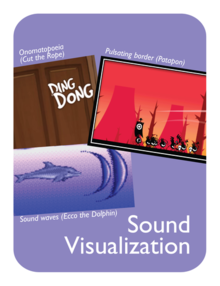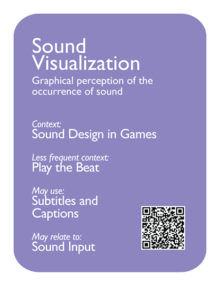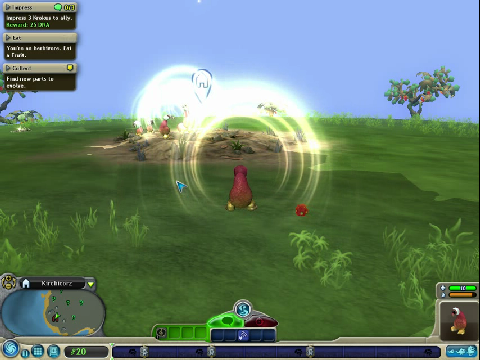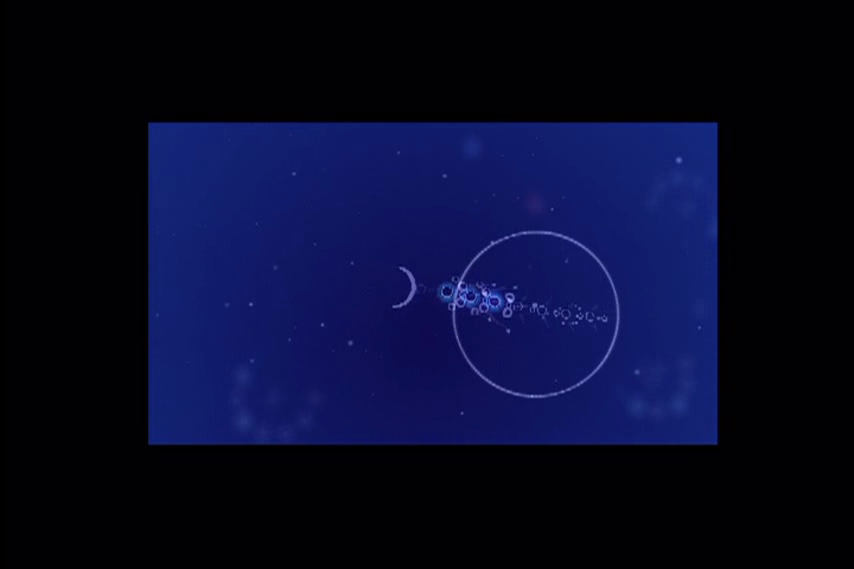Difference between revisions of "Sound Visualization"
From SoundInGames.com - Sound Design in Games
ValterAlves (Talk | contribs) m |
ValterAlves (Talk | contribs) m |
||
| Line 26: | Line 26: | ||
* In the particular case of [[Dialogue]]: overcome language comprehension difficulties by reading subtitles, possibly in another language, as explored in [[Subtitles and Captions]]. | * In the particular case of [[Dialogue]]: overcome language comprehension difficulties by reading subtitles, possibly in another language, as explored in [[Subtitles and Captions]]. | ||
| − | + | Most typical solutions adopted in games are (common too other other media): | |
*Diegetic approaches: | *Diegetic approaches: | ||
** Drawing sound waves, which allows to locate the source, and possibly the reach and the receptors of that sound, but does not allow to know the sound itself. | ** Drawing sound waves, which allows to locate the source, and possibly the reach and the receptors of that sound, but does not allow to know the sound itself. | ||
Revision as of 21:33, 21 August 2011

|

| |
| The card's front face | The card's back face |
Contents
Synopsis
| Graphical perception of the occurrence of sound. |
Relationships
Context:
Sound Design in Games ![]() .
.
Less frequent context:
Play the Beat File:M385px-PlayTheBeat-front-v20.png.
May use:
Subtitles and Captions ![]() .
.
May relate to:
Sound Input ![]() .
.
Description
Sound Visualization consists in poviding graphical representations to accompany occurring sounds. There are some reasons for this to be interesting:
- Emphasising some aspect of the sound, by providing a cross-modal reinforcement of the perception.
- Enabling the game to be played and enjoyed without sound. In turn this is critical in several circumstances:
- for playing in noisy environments (e.g. using mobile platforms)
- for playing in places where the context obliges that the sound is mute or very low volume.
- for deaf players[1]
- In the particular case of Dialogue: overcome language comprehension difficulties by reading subtitles, possibly in another language, as explored in Subtitles and Captions.
Most typical solutions adopted in games are (common too other other media):
- Diegetic approaches:
- Drawing sound waves, which allows to locate the source, and possibly the reach and the receptors of that sound, but does not allow to know the sound itself.
- Drawing an onomatopoeia, possibly next to the source of the sound, which allows to learn what sound it is, and possibly the source.
- Non-Diegetic approach:
- as explored in Subtitles and Captions: Inscribe a descriptor of the occurring sounds as captions, possibly interweaved with subtitles, which allows a verbose description of the several aspects of the sound
Examples
  Patapon: The all visual representation pulses with the sound - from the most objective, as the rectangle in the border and the drums' onomatopoeias (mapping the Sound Input), to the more subtle, as the moves and details of the characters (which map and the Sound Input and the sound they echo themselves).
|
  |
- ↑ Cite error: Invalid
<ref>tag; no text was provided for refs nameddeafplayerssite





